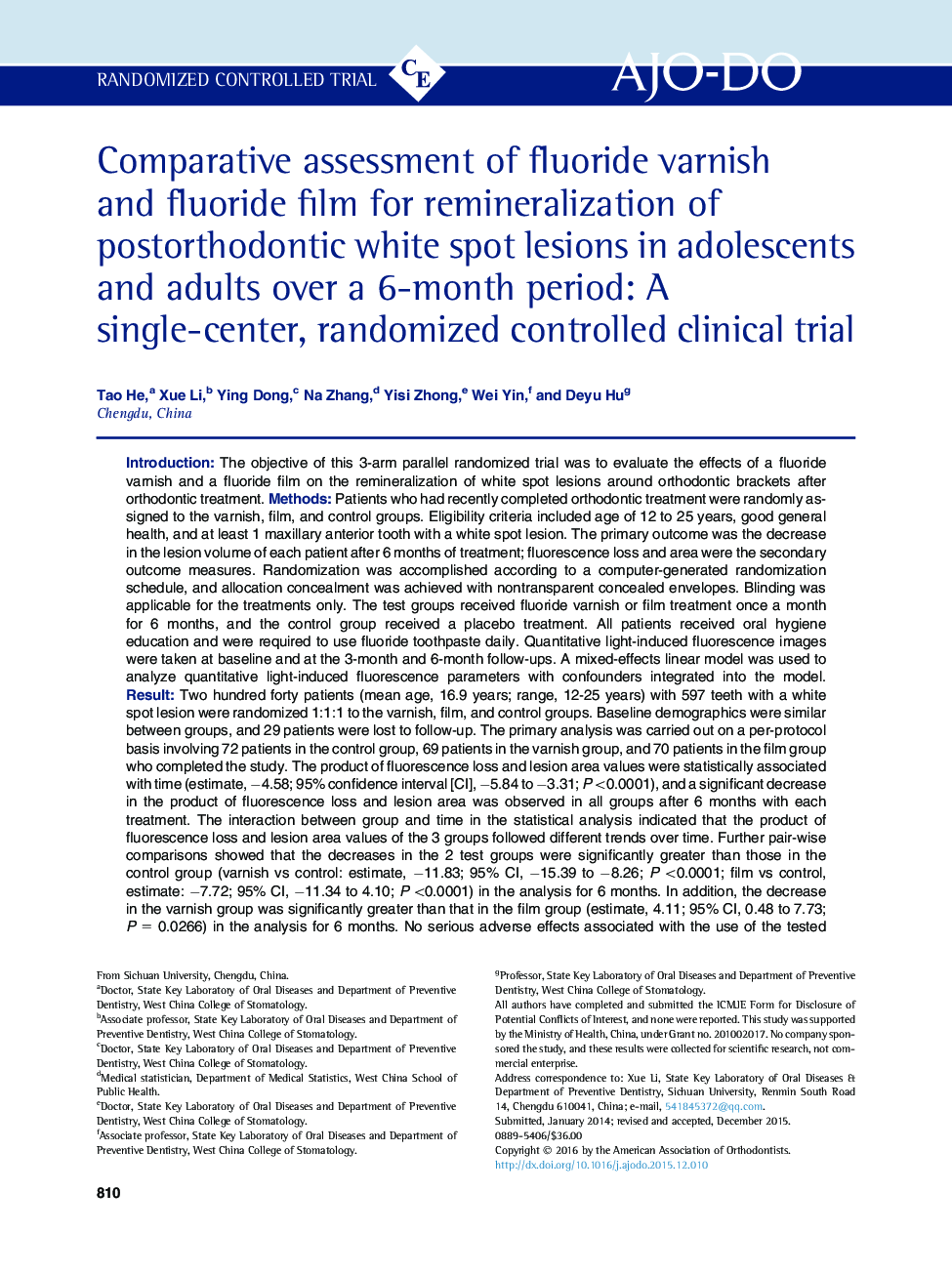| Article ID | Journal | Published Year | Pages | File Type |
|---|---|---|---|---|
| 3115566 | American Journal of Orthodontics and Dentofacial Orthopedics | 2016 | 10 Pages |
•Patients with white spot lesions were randomized to varnish, film, and control groups.•Some natural remineralization occurs after bracket removal.•Daily brushing with fluoride toothpaste aids remineralization.•Fluoride varnish or film induces greater remineralization.•Fluoride varnish may be slightly more effective than fluoride film.
IntroductionThe objective of this 3-arm parallel randomized trial was to evaluate the effects of a fluoride varnish and a fluoride film on the remineralization of white spot lesions around orthodontic brackets after orthodontic treatment.MethodsPatients who had recently completed orthodontic treatment were randomly assigned to the varnish, film, and control groups. Eligibility criteria included age of 12 to 25 years, good general health, and at least 1 maxillary anterior tooth with a white spot lesion. The primary outcome was the decrease in the lesion volume of each patient after 6 months of treatment; fluorescence loss and area were the secondary outcome measures. Randomization was accomplished according to a computer-generated randomization schedule, and allocation concealment was achieved with nontransparent concealed envelopes. Blinding was applicable for the treatments only. The test groups received fluoride varnish or film treatment once a month for 6 months, and the control group received a placebo treatment. All patients received oral hygiene education and were required to use fluoride toothpaste daily. Quantitative light-induced fluorescence images were taken at baseline and at the 3-month and 6-month follow-ups. A mixed-effects linear model was used to analyze quantitative light-induced fluorescence parameters with confounders integrated into the model.ResultTwo hundred forty patients (mean age, 16.9 years; range, 12-25 years) with 597 teeth with a white spot lesion were randomized 1:1:1 to the varnish, film, and control groups. Baseline demographics were similar between groups, and 29 patients were lost to follow-up. The primary analysis was carried out on a per-protocol basis involving 72 patients in the control group, 69 patients in the varnish group, and 70 patients in the film group who completed the study. The product of fluorescence loss and lesion area values were statistically associated with time (estimate, −4.58; 95% confidence interval [CI], −5.84 to −3.31; P <0.0001), and a significant decrease in the product of fluorescence loss and lesion area was observed in all groups after 6 months with each treatment. The interaction between group and time in the statistical analysis indicated that the product of fluorescence loss and lesion area values of the 3 groups followed different trends over time. Further pair-wise comparisons showed that the decreases in the 2 test groups were significantly greater than those in the control group (varnish vs control: estimate, −11.83; 95% CI, −15.39 to −8.26; P <0.0001; film vs control, estimate: −7.72; 95% CI, −11.34 to 4.10; P <0.0001) in the analysis for 6 months. In addition, the decrease in the varnish group was significantly greater than that in the film group (estimate, 4.11; 95% CI, 0.48 to 7.73; P = 0.0266) in the analysis for 6 months. No serious adverse effects associated with the use of the tested varnish, film, or placebo occurred.ConclusionsAfter removal of the orthodontic brackets, some natural remineralization of white spot lesions occurred, and daily use of fluoride toothpaste may be helpful for this process. However, not all patients experienced this remineralization, and treatment with fluoride varnish or fluoride film induced greater remineralization of white spot lesions. In addition, our results suggest that fluoride varnish may be slightly more effective than fluoride film. However, further similar clinical trials with more patients are needed to definitively determine which fluoride treatment is most effective.RegistrationThis trial was registered on the Chinese Clinical Trial Register, number ChiCTR-TRC-13003764.ProtocolThe details of the trial protocol are posted online at: http://apps.who.int/trialsearch/Trial.aspx?TrialID=ChiCTR-TRC-13003764.
